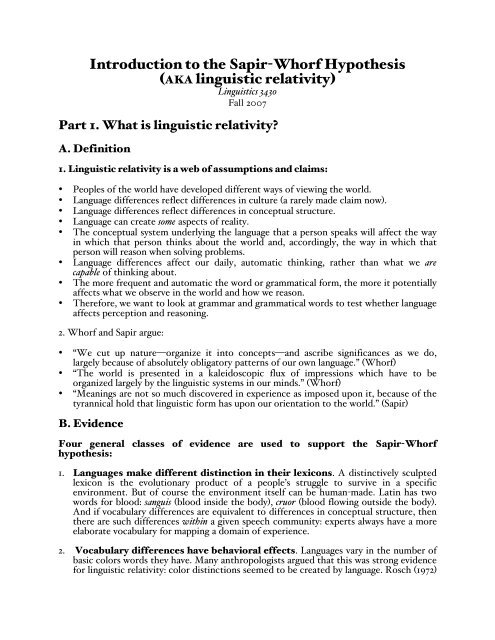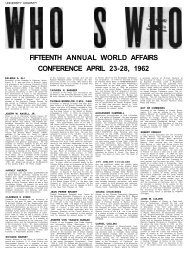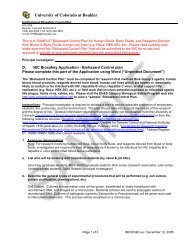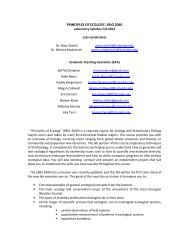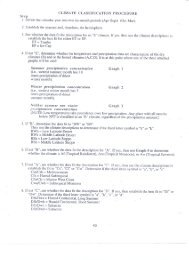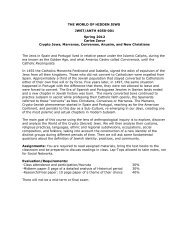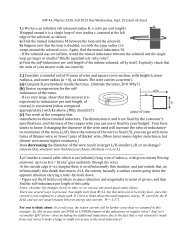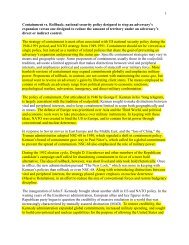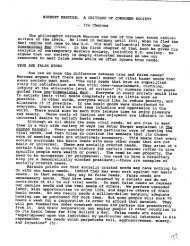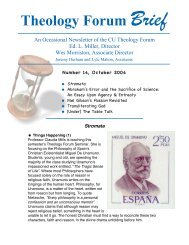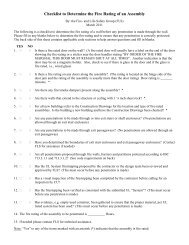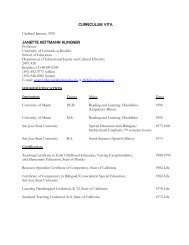Introduction to the Sapir-Whorf Hypothesis - University of Colorado ...
Introduction to the Sapir-Whorf Hypothesis - University of Colorado ...
Introduction to the Sapir-Whorf Hypothesis - University of Colorado ...
Create successful ePaper yourself
Turn your PDF publications into a flip-book with our unique Google optimized e-Paper software.
<strong>Introduction</strong> <strong>to</strong> <strong>the</strong> <strong>Sapir</strong>-<strong>Whorf</strong> Hypo<strong>the</strong>sis<br />
(AKA linguistic relativity)<br />
Linguistics 3430<br />
Fall 2007<br />
Part 1. What is linguistic relativity?<br />
A. Definition<br />
1. Linguistic relativity is a web <strong>of</strong> assumptions and claims:<br />
• Peoples <strong>of</strong> <strong>the</strong> world have developed different ways <strong>of</strong> viewing <strong>the</strong> world.<br />
• Language differences reflect differences in culture (a rarely made claim now).<br />
• Language differences reflect differences in conceptual structure.<br />
• Language can create some aspects <strong>of</strong> reality.<br />
• The conceptual system underlying <strong>the</strong> language that a person speaks will affect <strong>the</strong> way<br />
in which that person thinks about <strong>the</strong> world and, accordingly, <strong>the</strong> way in which that<br />
person will reason when solving problems.<br />
• Language differences affect our daily, au<strong>to</strong>matic thinking, ra<strong>the</strong>r than what we are<br />
capable <strong>of</strong> thinking about.<br />
• The more frequent and au<strong>to</strong>matic <strong>the</strong> word or grammatical form, <strong>the</strong> more it potentially<br />
affects what we observe in <strong>the</strong> world and how we reason.<br />
• Therefore, we want <strong>to</strong> look at grammar and grammatical words <strong>to</strong> test whe<strong>the</strong>r language<br />
affects perception and reasoning.<br />
2. <strong>Whorf</strong> and <strong>Sapir</strong> argue:<br />
• “We cut up nature—organize it in<strong>to</strong> concepts—and ascribe significances as we do,<br />
largely because <strong>of</strong> absolutely obliga<strong>to</strong>ry patterns <strong>of</strong> our own language.” (<strong>Whorf</strong>)<br />
• “The world is presented in a kaleidoscopic flux <strong>of</strong> impressions which have <strong>to</strong> be<br />
organized largely by <strong>the</strong> linguistic systems in our minds.” (<strong>Whorf</strong>)<br />
• “Meanings are not so much discovered in experience as imposed upon it, because <strong>of</strong> <strong>the</strong><br />
tyrannical hold that linguistic form has upon our orientation <strong>to</strong> <strong>the</strong> world.” (<strong>Sapir</strong>)<br />
B. Evidence<br />
Four general classes <strong>of</strong> evidence are used <strong>to</strong> support <strong>the</strong> <strong>Sapir</strong>-<strong>Whorf</strong><br />
hypo<strong>the</strong>sis:<br />
1. Languages make different distinction in <strong>the</strong>ir lexicons. A distinctively sculpted<br />
lexicon is <strong>the</strong> evolutionary product <strong>of</strong> a people’s struggle <strong>to</strong> survive in a specific<br />
environment. But <strong>of</strong> course <strong>the</strong> environment itself can be human-made. Latin has two<br />
words for blood: sanguis (blood inside <strong>the</strong> body), cruor (blood flowing outside <strong>the</strong> body).<br />
And if vocabulary differences are equivalent <strong>to</strong> differences in conceptual structure, <strong>the</strong>n<br />
<strong>the</strong>re are such differences within a given speech community: experts always have a more<br />
elaborate vocabulary for mapping a domain <strong>of</strong> experience.<br />
2. Vocabulary differences have behavioral effects. Languages vary in <strong>the</strong> number <strong>of</strong><br />
basic colors words <strong>the</strong>y have. Many anthropologists argued that this was strong evidence<br />
for linguistic relativity: color distinctions seemed <strong>to</strong> be created by language. Rosch (1972)
disagreed, arguing from research among Dani people (New Guinea; two basic color<br />
terms) that speakers <strong>of</strong> all language have <strong>the</strong> same physiological ability <strong>to</strong> perceive<br />
distinctions among <strong>the</strong> 11 ‘landmark’ colors. Berlin and Kay (1969) showed that <strong>the</strong>se<br />
landmark colors are <strong>the</strong> basis <strong>of</strong> color systems in all world languages However, color<br />
vocabulary still provides support for linguistic relativity: <strong>the</strong> number <strong>of</strong> basic words in a<br />
person’s color vocabulary influence how easy it is for that person <strong>to</strong> recognize those<br />
distinctions.<br />
The Kay-Kemp<strong>to</strong>n experiment (1984). This experiment involved a green-blue<br />
discrimination task. Subjects saw three color chips in <strong>the</strong> green-blue range. For example,<br />
Phase 1: Subjects: English speakers and Tarahumara speakers (for whom <strong>the</strong>re is a<br />
single word for green/blue, siyname). For 56 triads, subjects are asked: Which <strong>of</strong> <strong>the</strong> three<br />
chips is most different from <strong>the</strong> o<strong>the</strong>r two? English speakers picked Chip C while<br />
Tarahumaran subjects chose A or split evenly.<br />
Phase 2: Subjects: English speakers. Similar task <strong>to</strong> Phase 1, but this time subjects had a<br />
moving window through which <strong>the</strong>y could only see two chips at a time. They were asked<br />
<strong>to</strong> compare <strong>the</strong> relative ‘greenness’ <strong>of</strong> A and B and <strong>the</strong> relative ‘blueness’ <strong>of</strong> B and C.<br />
What did <strong>the</strong>y <strong>the</strong>n pick for <strong>the</strong> most different chip?<br />
3. Basic grammatical structure can differ radically from language <strong>to</strong> language.<br />
Even if we expect lexical distinctions <strong>to</strong> vary from culture <strong>to</strong> culture, we don’t expect<br />
basic grammar <strong>to</strong> vary much, because it supposedly reflects fundamental distinctions like<br />
mass vs. count and entity vs. property. But it does. For example, in Native American<br />
languages, <strong>the</strong>re is no clear grammatical separation between states <strong>of</strong> affairs and entities:<br />
Siberian Yupik<br />
angya -ghlla -ng -yug -tuq<br />
boat -augmentative-acquire -desire-3SG<br />
‘He wants <strong>to</strong> acquire a boat.’<br />
‘Boat-acquiring desire’<br />
Wichita (Caddoan, Oklahoma)<br />
kiya- -:ki -riwa:c -e:rhira -s -?irhawi<br />
quotative past big buffalo lie<br />
‘They say <strong>the</strong>re was a big buffalo lying <strong>the</strong>re.’<br />
‘Apparent past prone state <strong>of</strong> big buffalo’<br />
4. Grammatical structure has behavioral effects. For example, Navajo verb forms<br />
encode shape, flatness and flexibility <strong>of</strong> objects acted upon. Carroll and Casagrande<br />
(1958) studied what properties Navajo children use <strong>to</strong> group objects. They gave subjects a<br />
blue rope and yellow stick and asked which <strong>of</strong> <strong>the</strong> two goes with a blue stick. The<br />
2
Navajo-speaking children chose shape (yellow stick); <strong>the</strong> English-speaking children<br />
choose color (blue rope).<br />
C. How exotic are <strong>the</strong> phenomena that <strong>Whorf</strong> describes?<br />
<strong>Whorf</strong> was writing at a time when <strong>the</strong> structure <strong>of</strong> non-Indo-European languages was poorly<br />
unders<strong>to</strong>od. It is not news <strong>to</strong> any linguist working <strong>to</strong>day that not all languages have tense,<br />
that not all languages have <strong>the</strong> same metaphorical models, that not all languages have<br />
grammatical relations like subject and object, that not all languages have constituents like<br />
NP (noun phrase) and VP (verb phrase), that some languages may lack frequency adverbs<br />
like twice.<br />
Part 2. <strong>Whorf</strong>’s Studies<br />
A. <strong>Whorf</strong>’s Life and Views<br />
• Benjamin Lee <strong>Whorf</strong> (1897-1941) had a degree in chemical engineering from MIT.<br />
• He worked as a fire insurance inspec<strong>to</strong>r for <strong>the</strong> Hartford Fire Insurance Company,<br />
pursuing linguistic and anthropological studies as a hobby.<br />
• In 1931, <strong>Whorf</strong> began working with Edward <strong>Sapir</strong> at Yale <strong>University</strong>.<br />
• He worked on decipherment <strong>of</strong> Mayan hieroglyphs and Hopi grammar, among o<strong>the</strong>r<br />
things.<br />
• So, he was working with two very different groups: indigenous peoples and befuddled<br />
people at fire scenes. Somehow, he came <strong>to</strong> see <strong>the</strong>m as similar: <strong>the</strong>ir reasoning made<br />
sense <strong>to</strong> him only once he unders<strong>to</strong>od how language had formed <strong>the</strong>ir thinking.<br />
• Most <strong>of</strong> his work was published in <strong>the</strong> popular press.<br />
• He is mainly known for a posthumous collection <strong>of</strong> his work, Language, Thought, and<br />
Reality (1956).<br />
• His views don’t seem radical <strong>to</strong>day: he believes that <strong>the</strong>re are different ways <strong>of</strong> viewing<br />
<strong>the</strong> world, that language influences (but doesn’t determine) daily thought and that<br />
conceptual systems evolve.<br />
• As Lak<strong>of</strong>f (1987) point out, he doesn’t seem <strong>to</strong> recognize that language flexibility: we can<br />
conceive <strong>of</strong> one thing (e.g., time, love) in two different ways.<br />
• He also focuses on ‘reality’ ra<strong>the</strong>r than on culturally constructed concepts.<br />
B. ‘An American Indian Model <strong>of</strong> <strong>the</strong> Universe’<br />
1. Hopi speakers have “no general notion <strong>of</strong> time as a smooth flowing continuum in which<br />
everything in <strong>the</strong> universe proceeds at an equal rate, out <strong>of</strong> a future, through a present<br />
and in<strong>to</strong> a past; or, in which, <strong>to</strong> reverse <strong>the</strong> picture, <strong>the</strong> observer is being carried in <strong>the</strong><br />
stream <strong>of</strong> duration continuously away from a past and in<strong>to</strong> a future” (p. 57)<br />
2. <strong>Whorf</strong> argues that Hopi contains no words or grammatical forms that refer directly <strong>to</strong><br />
time. Instead, <strong>the</strong> grammar marks a difference between MANIFEST/OBJECTIVE and<br />
MANIFESTING/SUBJECTIVE (or unmanifest). The manifest domain includes present and<br />
past. The subjective (or manifesting) domain includes <strong>the</strong> future, mental states, and<br />
mythical events.<br />
3. The TIME IS SPACE metaphor is also lacking: distance between events is measured in<br />
terms <strong>of</strong> <strong>the</strong> number <strong>of</strong> “periodic physical motions [which] have occurred between<br />
<strong>the</strong>m” (p. 63).<br />
3
4. Events that occurred outside <strong>the</strong> speaker’s view are reported by means <strong>of</strong> subjective<br />
marking, since <strong>the</strong>re is only indirect evidence for <strong>the</strong>m. This type <strong>of</strong> system is called an<br />
EVIDENTAL SYSTEM. It is common in <strong>the</strong> world’s languages.<br />
Turkish<br />
Dirseg-im- i vur -du -um<br />
elbow 1SG.poss OBJ hit PST 1SG<br />
“I hit my elbow!”<br />
Dirseg-im- i vur -mus -um<br />
elbow 1SG.POSS OBJ hit PST 1SG<br />
“I must have hit my elbow!” (inference)<br />
“They tell me I hit my elbow.” (hearsay)<br />
B. ‘Languages and Logic’<br />
1. <strong>Whorf</strong>’s main point: “Facts are unlike <strong>to</strong> speakers whose language background<br />
provides for unlike formulation <strong>of</strong> <strong>the</strong>m” (p. 235).<br />
Shawnee (Algonquian, Oklahoma) vs. English.<br />
(a) I pull <strong>the</strong> branch aside.<br />
(b) I have an extra <strong>to</strong>e on my foot.<br />
Shawnee<br />
ni- l’thawa- ’ko -n- a<br />
1SG fork outline branch hand action cause<br />
ni -l’thawa- ’ko- thite<br />
1SG fork outline branch pertaining <strong>to</strong> <strong>to</strong>es<br />
(c) I push his head back.<br />
(d) I drop it and it floats.<br />
Shawnee<br />
ni- -kwashkwi- -tepe -n- -a<br />
1SG recoil locus at head hand action cause<br />
ni- -kwashk- -ho -<strong>to</strong>-<br />
1SG recoil locus at water cause <strong>to</strong> inanimate<br />
(e) The boat is grounded on <strong>the</strong> beach.<br />
(f) The boat is manned by a select group <strong>of</strong> men.<br />
Both are statements about <strong>the</strong> boat. They are similar in this regard. But in Nootka,<br />
<strong>the</strong>se two sentences are not similar.<br />
Nootka (Wakashan, Southwestern British Columbia)<br />
4
tlih is ma<br />
moving pointwise on <strong>the</strong> beach manifest<br />
lash tskwiq ista ma<br />
select result in a canoe as a crew manifest<br />
2. Observations<br />
• There is no subject-predicate division in Nootka, contrary <strong>to</strong> Aris<strong>to</strong>tle’s claims about<br />
<strong>the</strong> primal nature <strong>of</strong> this division.<br />
• There are not even words as we know <strong>the</strong>m.<br />
• There is no division between nouns and verbs.<br />
• Sentences are <strong>the</strong> same as words, i.e., a root plus prefixes and suffixes. (‘Polysyn<strong>the</strong>sis’)<br />
• Language does not provide an unmediated picture <strong>of</strong> reality (compare Reddy’s paper on<br />
<strong>the</strong> conduit metaphor).<br />
• “[T]o restrict thinking <strong>to</strong> English...is <strong>to</strong> lose a power <strong>of</strong> thought which once lost can<br />
never be regained. It is <strong>the</strong> “plainest” English which contains <strong>the</strong> greatest number <strong>of</strong><br />
unconscious assumptions about nature.” (p. 244)<br />
• The very thought <strong>of</strong> learning from o<strong>the</strong>r language patterns about ways <strong>of</strong> conceiving <strong>of</strong><br />
<strong>the</strong> world defies a strict version <strong>of</strong> linguistic relativity.<br />
C. ‘The Relation <strong>of</strong> Habitual Thought and Behavior <strong>to</strong> Language’<br />
1. <strong>Whorf</strong> says: “All real scientist have <strong>the</strong>ir eyes primarily on background phenomena in<br />
our daily lives, and yet <strong>the</strong>ir studies have a way <strong>of</strong> bringing out a close relationship<br />
between <strong>the</strong>se unsuspected realms and foreground activities”.<br />
2. Our man from <strong>the</strong> Hartford Fire Insurance Company comments on linguistic<br />
contribu<strong>to</strong>rs <strong>to</strong> industrial fires. He describes a set <strong>of</strong> accidents with decreasingly<br />
plausible linguistic angles:<br />
‘Empty’ as applied <strong>to</strong> gasoline drums.<br />
Spun limes<strong>to</strong>ne as being noncombustible: s<strong>to</strong>ne as inert.<br />
Overheated varnish moved ‘<strong>of</strong>f’ <strong>the</strong> flame: cause as contact.<br />
Scrap lead containing paraffin on coal-fire melting pot.<br />
Coat on heater: ‘light turned on/<strong>of</strong>f’.<br />
Match in <strong>the</strong> tannery pond: water as noncombustible.<br />
Spark in <strong>the</strong> blower, which can ‘exhaust as well as blow’.<br />
3. “The cue <strong>to</strong> a certain line <strong>of</strong> behavior is <strong>of</strong>ten given by <strong>the</strong> analogies <strong>of</strong> <strong>the</strong> linguistic<br />
formula in which <strong>the</strong> situation is spoken <strong>of</strong>, and by which <strong>to</strong> some degree it is analyzed,<br />
classified and allotted its place in that world which is ‘<strong>to</strong> a large extent built up on <strong>the</strong><br />
language habits <strong>of</strong> <strong>the</strong> group. And we always assume <strong>the</strong> linguistic analysis made by our<br />
group reflects reality better than it does.” (p. 137)<br />
4. Turning away from individual words and phrases, <strong>Whorf</strong> focuses on <strong>the</strong> grammatical<br />
structure <strong>of</strong> languages. He asks two main questions:<br />
• Are <strong>the</strong> concepts <strong>of</strong> TIME, SPACE and MATTER manifested in similar ways in all<br />
languages? For <strong>Whorf</strong>, a negative answer <strong>to</strong> this question would indicate that different<br />
language communities experience <strong>the</strong> world in different ways.<br />
5
• Are grammatical patterns related <strong>to</strong> cultural and behavioral norms?<br />
5. The category <strong>of</strong> MATTER has two different manifestations in language:<br />
entities and reified entities (like time).<br />
(a) Reification. We can make events in<strong>to</strong> countable units and abstract concepts in<strong>to</strong><br />
substances. In SAE, a cyclic phenomenon (passage <strong>of</strong> days) leads <strong>to</strong> <strong>the</strong> counting <strong>of</strong> units<br />
(‘10 days’, etc.). In Hopi, <strong>the</strong>re are no time units (or so <strong>Whorf</strong> claims).<br />
(b) Entities. Languages differ in how or whe<strong>the</strong>r <strong>the</strong>y distinguish between MASSES and<br />
COUNTABLE OBJECTS. Despite what <strong>Whorf</strong> implies, Native American languages do<br />
distinguish between masses and countable objects (see Lakhota example below).<br />
• Mass vs. count in English.<br />
*She saw cat.<br />
She saw a cat.<br />
She saw cats.<br />
She drank c<strong>of</strong>fee.<br />
? She drank waters.<br />
? She drank a water.<br />
• Mass vs. count in French: mass nouns receive <strong>the</strong> partitive article:<br />
Je voudrais encore du vin.<br />
‘I would like some more wine.’<br />
On a mangé de la choucroute.<br />
‘We ate some sauerkraut.’<br />
• Mass vs. count in Vietnamese: no distinction; all specific nouns get a CLASSIFIER.<br />
Tôi an món cá.<br />
I ate ‘dish’ classifier fish<br />
‘I ate fish.’<br />
Tôi mua cón cá.<br />
I buy animal classifier fish<br />
‘I bought a fish.’<br />
Tôi doc tò báo.<br />
I read ‘paper’ classifier newspaper.<br />
‘I read <strong>the</strong> newspaper.’<br />
Tôi goi ông quan-ly.<br />
I call ‘age-mate male’ classifier manager<br />
‘I called <strong>the</strong> manager.’<br />
• Mass vs. count in Finnish: boundedness signaled by <strong>the</strong> noun<br />
Join kahvia<br />
drank-1SG c<strong>of</strong>fee-PART<br />
‘I drank some c<strong>of</strong>fee.’<br />
6
‘I was drinking c<strong>of</strong>fee.’<br />
Join kahvin<br />
drank-1SG c<strong>of</strong>fee-ACC<br />
‘I drank <strong>the</strong> c<strong>of</strong>fee.’<br />
‘I a drank a cup <strong>of</strong> c<strong>of</strong>fee.’<br />
• Mass vs. count in Czech: boundedness signaled by <strong>the</strong> verb<br />
Pil víno<br />
drink:3SG:MASC:IMPERF wine<br />
‘He was drinking some wine.’<br />
‘He drank wine.’<br />
Vypil víno.<br />
drink:3SG:MASC:PERF wine<br />
‘He drank <strong>the</strong> wine.’<br />
‘He drank a glass <strong>of</strong> wine.’<br />
• Mass vs. count in Lakhota: boundedness indicated by determiner selection<br />
Mní ki blatké yelo.<br />
water def I.drank declarative<br />
‘I drank <strong>the</strong> water.’<br />
Mní eyá blatké yelo.<br />
water some I.drank declarative<br />
‘I drank some water.’<br />
6. The category <strong>of</strong> SPACE has two different manifestations in language: TIME-<br />
SPACE METAPHORS and SPATIAL RELATIONS.<br />
(a) Hopi has no time-space metaphors according <strong>to</strong> <strong>Whorf</strong>.<br />
(b) However, it does have concepts like near and far, above and below.<br />
(c) Malotki (1983) argues against <strong>Whorf</strong>’s view <strong>of</strong> Hopi:<br />
…<strong>the</strong> technique <strong>of</strong> spatio-temporal metaphorization is a ubiqui<strong>to</strong>us phenomenon in<br />
Hopi. It involves not only countless postpositions and adverbs <strong>of</strong> place but also a<br />
number <strong>of</strong> verbs and nouns, among <strong>the</strong>m a direct equation <strong>of</strong> <strong>the</strong> noun qeni ‘space’<br />
with <strong>the</strong> notion ‘time’. (p. 15).<br />
Malotki’s examples include:<br />
Nu pay tsa-y-ngahaqa-qw ya-n yu’a-‘a-ta<br />
I ASSR small-size-INDEF-from this-way talk-RDP-IMPRF<br />
‘I’ve been talking this way from childhood.’<br />
Suu-kw taala-t pam a-w hoyo-k-na<br />
One-ACC day-ACC that REF-<strong>to</strong> move-k-CAUS<br />
‘He added one day <strong>to</strong> it.’<br />
7
7. The category <strong>of</strong> TIME has two different manifestations in language:<br />
TEMPORAL SEQUENCE and TENSE<br />
(a) <strong>Whorf</strong> observes that Hopi has no tense.<br />
(b) However, Hopi does have ways <strong>of</strong> indicating simultaneity and anteriority via<br />
subordinate clauses.<br />
(c) What’s so important about tense anyway?<br />
• In Vietnamese, <strong>the</strong>re are no obliga<strong>to</strong>ry tenses:<br />
Có môt nguòi dàn bà thuong tói tiêm cà phê môi sang chúa nhât dê mua cà phê.<br />
‘There’s a lady who always comes in<strong>to</strong> <strong>the</strong> café every Sunday morning <strong>to</strong> get c<strong>of</strong>fee.<br />
Ba ta rât là xâu, ngu và mâp nhu con heo.<br />
She is very ugly, stupid and fat, like a pig.<br />
Môt hôm bà ta dên và tôi dang nói chuyên voi môt nguòi ban làm.<br />
One day she arrived and I was chatting with a work friend.<br />
Tôi hoi ban làm cua tôi rang: “Anh có muôn cuoi môt nguòi vo ngu và mâp nhu bà ta không?”<br />
I asked my friend, “Would you want <strong>to</strong> marry someone stupid and fat like that?”<br />
Bông bà ây nghe chúng tôi dang nói chuyên vê bà ây<br />
Suddenly <strong>the</strong> woman realized that we were talking about her<br />
và bà ây phàn-nhan cùng vói ông chu cua tôi.<br />
and she went <strong>to</strong> complain <strong>to</strong> my boss.<br />
[…] Và ông chu cua tôi muôn tôi xin lôi bà ây<br />
And my boss wanted me <strong>to</strong> apologize <strong>to</strong> her<br />
nhung tôi da không xin lôi bà ây vì tôi ghét bà ây lam.<br />
but I never did because I really hated her.<br />
• In Latin, <strong>the</strong>re is no one grammatical category that we could refer <strong>to</strong> as <strong>the</strong> Past tense.<br />
There are two Past forms, one for events and one for states:<br />
Marius ad Zamam pervenit. Id<br />
Marius:N <strong>to</strong> Zama:A went:3g:perf:act:ind it:N<br />
oppidum munitum erat.<br />
<strong>to</strong>wn:N fortified:N was:3sg:imp:act:ind<br />
“Marius went <strong>to</strong> Zama. That <strong>to</strong>wn was well fortified.” (Sallust, Jugurtha 57.1)<br />
8. Habitual thought in SAE and Hopi.<br />
• Hopi emphasis on preparedness can be traced <strong>to</strong> <strong>the</strong> linguistic system, in which days are<br />
not distinct but successive iterations.<br />
• The Hope worldview is fatalistic, as signaled by a linguistic encoding <strong>of</strong> unfolding events<br />
as ‘manifesting’.<br />
8
• The ‘Standard Average European’ mentality is one in which time is quantified, allocated,<br />
measured.<br />
• The TIME AS A RESOURCE metaphor is said by <strong>Whorf</strong> <strong>to</strong> stem from this mindset.<br />
• <strong>Whorf</strong> doubts that a metaphor in which time is matter is primal. It stems from an<br />
industrialized culture in which measurement <strong>of</strong> time became crucial.<br />
• Does <strong>Whorf</strong> believe that language influences culture? That culture influences language?<br />
• “There are connections but not correlations or diagnostic correspondences between<br />
cultural norms and linguistic patterns.”<br />
• “There is a relation between a language and <strong>the</strong> rest <strong>of</strong> <strong>the</strong> culture <strong>of</strong> <strong>the</strong> society that<br />
uses it.” (p. 159)<br />
• Does <strong>Whorf</strong> avoid circular argumentation? That is, arguments <strong>of</strong> <strong>the</strong> following form:<br />
this grammatical form implicates this fact about <strong>the</strong> culture; this culture is one that<br />
would require this form.<br />
9


